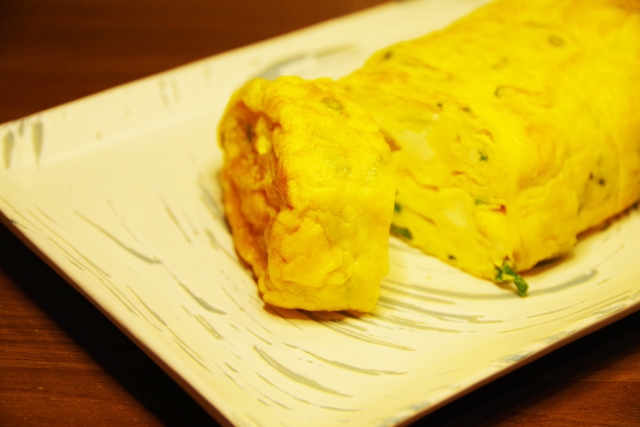Tamagoyaki used to be the most popular food for kids at lunch, including for me. Tamagoyaki is a Japanese omelet.
Egg yolks
A couple years ago, when I went back to Japan for a visit, I noticed egg yolks were a very vivid reddish-yellow color, much different from Canadian eggs. I wondered why Canadian egg yolks were such a plain yellow. I found out that diet contributed to the color of the yolks. If the diet contains yellow or orange plants, those colors will be deposited in the yolks. In North America, hens are fed grain and milo. In Japan, they are fed corn and soybean oil cake. That is why the color of Japanese egg yolks is a eddish yellow. Japanese like the reddish-yellow color of yolks, similar to people who live in the southern part of Europe. The people in northern Europe like plain yellow yolks like North Americans.
Types of Eggs
There are two kinds of eggs, white and brown. White eggs come from white-feathered chicken. Brown eggs come from red-feathered. I used to think that brown eggs had more nutritional value, but it actually has nothing to do with the color of the shell or yolk. Nutritional value is based on the hens’ diet and how it was raised.
Eggs that come from chickens which are raised in a pen have less nutritional value than free-range chicken. Also, eggs laid in the winter are denser than those laid in the summer because chickens drink more water in the summer.
How to Make Tamagoyaki
Dashimaki, another name for Tamagoyaki, is normally cooked with traditional Japanese soup stock (fish-based). I don’t use soup stock but simply add more sugar.
It is very simple to cook Tamagoyaki. Beat eggs and season with sugar, salt and soy sauce. When adding the soy sauce, add very little otherwise the golden yellow color of Tamagoyaki will be ruined.
We usually use a special oblong pan for Tamagoyaki in Japan, but I use an ordinary pan here. Warm up the pan. Coat the pan with oil and pour a thin layer of egg, like how you would do for crêpes. Roll it up with a spatula when the egg is half cooked, then move it close to you. Pour another thin layer of egg and roll it up with the egg already in the pan. Repeat until all th egg has been cooked.
You can create your own Tamagoyaki by adding greens such as boiled broccoli, chopped into small pieces, or placing boiled spinach in the center. You can also place seaweed on each layer of egg. Green veggies give it a nice color combination.
I always cook Tamagoyaki whenever I make a lunch box. If there is no Tamagoyaki, I feel like there is a hole in my lunch box.
